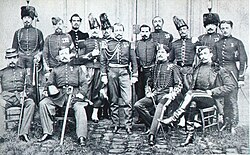This is an old revision of this page, as edited by Per Honor et Gloria (talk | contribs) at 13:55, 22 March 2008 (Creation). The present address (URL) is a permanent link to this revision, which may differ significantly from the current revision.
Revision as of 13:55, 22 March 2008 by Per Honor et Gloria (talk | contribs) (Creation)(diff) ← Previous revision | Latest revision (diff) | Newer revision → (diff)The development of France-Japan relations in the 19th century coincided with Japan's opening to the Western world, following two centuries of seclusion under the "Sakoku" system and France's expansionist policy in Asia. The two countries became very important partners from the second half of the 19th century in the military, economic, legal and artistic fields. The Bakufu modernized its army through the assistance of French military missions (Jules Brunet), and Japan later relied on France for several aspects of its modernization, particularly the development of a shipbuilding industry during the early years of the Imperial Japanese Navy (Emile Bertin), and the development of a Legal code. France also derived part of its modern artistic inspiration from Japanese art, essentially through Japonism and its influence on Impressionism, and almost completely relied on Japan for its prosperous silk industry.
Context

Japan had had numerous contacts with the West during the Nanban trade period in the second half of the 16th and the early 17th century. During that period, the first contacts between the French and the Japanese occured when the samurai Hasekura Tsunenaga landed in the southern French city of Saint-Tropez in 1615. François Caron, son of French Huguenot refugees to the Netherlands, who entered the Dutch East India Company, and became the first person of French origin to set foot in Japan in 1619. He stayed in Japan for 20 years, where he becomes a Director for the company.
This period of contact ended with the persecution of the Christian faith in Japan, leading to a near-total closure of the country to foreign interaction. In 1636, Guillaume Courtet, a French Dominican priest, penetrated into Japan in clandestinity, against the 1613 interdiction of Christianity. He was caught, tortured, and died in Kagoshima on September 29, 1637.
First contacts

After nearly two century of strictly enforced seclusion, various contacts occured from the middle of the 19th century as France was trying to expand its influence in Asia. In 1844, a French naval expedition under Captain Fornier-Duplan onboard Alcmène visited Okinawa on April 28, 1844. Trade was denied, but Father Forcade is left behind with a translator. In 1846, Admiral Cecille arrived in Nagasaki, but was denied landing.
Following the opening of Japan by the American Commodore Perry in 1852-1854, France obtained a treaty with Okinawa on November 24, 1855. In 1858, the first treaty between France and Japan was signed in Edo on October 9, 1858, by Jean Baptiste Louis Gros, opening diplomatic relations between the two countries. In 1859, Gustave Duchesne de Bellecourt arrived.

The Japanese soon responded to these contacts by sending their own embassies to France. The Shogun sends First Japanese Embassy to Europe, led by Takenouchi Yasunori in 1862. A Second Japanese Embassy to Europe in 1863.

- 1864. Arrival of Leon Roches in Japan.
- 1864. Bombardment of Shimonoseki by allied ships (9 British, 3 French, 4 Dutch, 1 American).
- 1864. In November Leonce Verny arrives in Japan for the construction of the Yokosuka arsenal.
- 1865. Shibata Takenaka visits France to prepare for the construction of the Yokosuka arsenal and organize a French military mission to Japan.

- 1867. The first French Military Mission to Japan arrives in Yokohama January 13, 1867. Among them is Captain Jules Brunet.
- 1867. Japan sends a delegation to the 1867 World Fair in Paris.
- 1867. The French mining engineer Francois Coignet is sent to Japan and is put in charge of the gold mines of Ikuno in 1868.
- 1868. Kobe incident (January 11th). A fight erupts in Akashi between 450 samurai of the Okayama fief and French sailors, leading to the occupation of central Kobe by foreign troops.
- 1868. Eleven French sailors from the Dupleix are killed in the Sakai incident, in Sakai, near Osaka, by southern rebel forces.
- 1869. Former French advisors under Jules Brunet fight alongside the last Shogun loyalists of Enomoto Takeaki, against Imperial troops in the Battle of Hakodate.
- 1870. Henri Pelegrin directs the construction of Japan's first gas-lightning system in the streets of Nihonbashi, Ginza and Yokohama.
- 1872. Paul Brunat opens the first modern Japanese silk spinning factory at Tomioka. Three craftsmen from the Nishijin weaving district in Kyoto, Sakura tsuneshichi, Inoue Ihee and Yoshida Chushichi travel to Lyon. They travel back to Japan in 1873, importing a Jacquard loom.
- 1872. Start of the second French Military Mission to Japan (1872-1880).
- 1873. The legal expert Gustave Emile Boissonade is sent to Japan to help build a modern legal system.
- 1874. The Second French Military Mission is sent to Japan, and builds the military school of Ichigaya.
- 1882. The first tramways are introduced from France and start functioning at Asakusa, and between Shinbashi and Ueno.
- 1884. Third French Military Mission to Japan (1884-1889).
- 1886. The French Navy engineer Emile Bertin reinforces the Japanese Navy, and directs the construction of the arsenals of Kure and Sasebo, contributing to the Japanese victory in the First Sino-Japanese war.

- 1898. The first automobile (a Panhard-Levassor) is introduced in Japan.
Notes
References
- Christian Polak, Soie et Lumières, Chambre de Commerce et d'Industrie Francaise au Japon, 2001
- Polak, p.13
- Source and